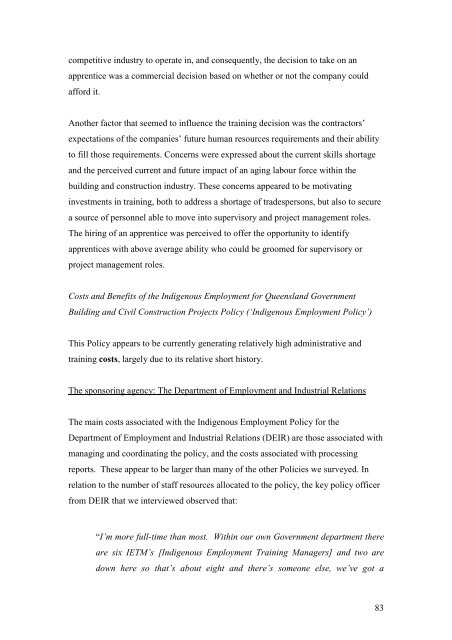Multi Outcome Construction Policy (final report)
Multi Outcome Construction Policy (final report)
Multi Outcome Construction Policy (final report)
You also want an ePaper? Increase the reach of your titles
YUMPU automatically turns print PDFs into web optimized ePapers that Google loves.
competitive industry to operate in, and consequently, the decision to take on anapprentice was a commercial decision based on whether or not the company couldafford it.Another factor that seemed to influence the training decision was the contractors’expectations of the companies’ future human resources requirements and their abilityto fill those requirements. Concerns were expressed about the current skills shortageand the perceived current and future impact of an aging labour force within thebuilding and construction industry. These concerns appeared to be motivatinginvestments in training, both to address a shortage of tradespersons, but also to securea source of personnel able to move into supervisory and project management roles.The hiring of an apprentice was perceived to offer the opportunity to identifyapprentices with above average ability who could be groomed for supervisory orproject management roles.Costs and Benefits of the Indigenous Employment for Queensland GovernmentBuilding and Civil <strong>Construction</strong> Projects <strong>Policy</strong> (‘Indigenous Employment <strong>Policy</strong>’)This <strong>Policy</strong> appears to be currently generating relatively high administrative andtraining costs, largely due to its relative short history.The sponsoring agency: The Department of Employment and Industrial RelationsThe main costs associated with the Indigenous Employment <strong>Policy</strong> for theDepartment of Employment and Industrial Relations (DEIR) are those associated withmanaging and coordinating the policy, and the costs associated with processing<strong>report</strong>s. These appear to be larger than many of the other Policies we surveyed. Inrelation to the number of staff resources allocated to the policy, the key policy officerfrom DEIR that we interviewed observed that:“I’m more full-time than most. Within our own Government department thereare six IETM’s [Indigenous Employment Training Managers] and two aredown here so that’s about eight and there’s someone else, we’ve got a83
















